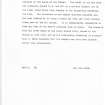Bute, Cnoc An Rath
Earthwork (Period Unassigned)(Possible)
Site Name Bute, Cnoc An Rath
Classification Earthwork (Period Unassigned)(Possible)
Alternative Name(s) Knock-na-raw, Crock-kan-raa
Canmore ID 40318
Site Number NS06NW 10
NGR NS 03506 67262
Datum OSGB36 - NGR
Permalink http://canmore.org.uk/site/40318
- Council Argyll And Bute
- Parish North Bute
- Former Region Strathclyde
- Former District Argyll And Bute
- Former County Buteshire
NS06NW 10 03506 67262.
(NS 0350 6725) Cnoc an Rath (NAT) Earthwork (R)
OS 6" map (1957)
Cnoc an Rath, a huge green mound, appears to have formerly been fortified. According to Lytteil, 'great quantities of the stones which formed the ramparts have been removed within the memory of people still living'. Hewison could find no trace of stone in the ramparts, and concludes that they were earthen. The oval area enclosed is about 100 yards N-S by 44 yards, situated about 60ft above the level of the burn at its west base.
J K Hewison 1893
A large, natural, oval and flat-topped hillock with no trace of any artificial work about it.
Marshall suggests that it was 'a river terrace that had been adapted to make a stonghold and that the surrounding ramparts have been almost entirely ploughed out' (D Marshall 1974).
Visited by OS (BS) 24 November 1976
Cnoc an Rath is a natural, steep-sided knoll 130m WNW of Lower Ettrick farmsteading (NS06NW 103), which has been formed from an eroded promontory of a river terrace. The summit comprises a flat, roughly oval area measuring about 85m from NNE to SSW by 35m transversely, which is only easily accessed from the rest of the river terrace by a narrow neck of land on the NNE. On the date of visit the site was under grass and no evidence of ramparts or internal structures was found.
Despite earlier suggestions that this knoll has been fortified, there is no compelling evidence to classify this site as anything other than a possible enclosure. ‘Knocknarath' is depicted on May's estate map (1780-82) as an area of cultivation and it is also shown on Mackinlay's Map of North Bute, dated 1823, and the 1st edition of the OS 6-inch map (Argyllshire and Buteshire 1869, Sheet CXCIII). Given that the knoll has been under cultivation for a considerable length of time, it is possible that the wall that was ‘still visible in places’ to the writer of the OS Name Book about 1863 (No.5, p.17) was nothing more than the remains of an old field boundary.
Visited by RCAHMS (GFG, PJD) 22 May 2009.
Antiquarian Mapping (1780 - 1782)
Antiquarian Mapping (1823)
Reference (1855)
Field Visit (1864)
This fort was depicted on the 1st edition of the OS 6-inch map (Argyllshire and Buteshire 1869, Sheet CXCIII) and described in the contemporary Name Book (Buteshire No.5, p.17).
Field Visit (1893)
Cnoc an Rath, a huge green mound, appears to have formerly been fortified. According to Lytteil, 'great quantities of the stones which formed the ramparts have been removed within the memory of people still living'. Hewison could find no trace of stone in the ramparts, and concludes that they were earthen. The oval area enclosed is about 100 yards N-S by 44 yards, situated about 60ft above the level of the burn at its west base.
J K Hewison 1893
Field Visit (22 May 1943)
This site was recorded as part of the RCAHMS Emergency Survey, undertaken by Angus Graham and Vere Gordon Childe during World War 2. The project archive has been catalogued during 2013-2014 and the material, which includes notebooks, manuscripts, typescripts, plans and photographs, is now available online.
Information from RCAHMS (GF Geddes) 2 December 2014.
Reference (1974)
Field Visit (24 November 1976)
A large, natural, oval and flat-topped hillock with no trace of any artificial work about it.
Marshall suggests that it was 'a river terrace that had been adapted to make a stronghold and that the surrounding ramparts have been almost entirely ploughed out' (D Marshall 1974).
Visited by OS (BS) 24 November 1976
Field Visit (22 May 2009)
Cnoc an Rath is a natural, steep-sided knoll 130m WNW of Lower Ettrick farmsteading (NS06NW 103), which has been formed from an eroded promontory of a river terrace. The summit comprises a flat, roughly oval area measuring about 85m from NNE to SSW by 35m transversely, which is only easily accessed from the rest of the river terrace by a narrow neck of land on the NNE. On the date of visit the site was under grass and no evidence of ramparts or internal structures was found.
Despite earlier suggestions that this knoll has been fortified, there is no compelling evidence to classify this site as anything other than a possible enclosure. ‘Knocknarath' is depicted on May's estate map (1780-82) as an area of cultivation and it is also shown on Mackinlay's Map of North Bute, dated 1823, and the 1st edition of the OS 6-inch map (Argyllshire and Buteshire 1869, Sheet CXCIII). Given that the knoll has been under cultivation for a considerable length of time, it is possible that the wall that was ‘still visible in places’ to the writer of the OS Name Book about 1863 (No.5, p.17) was nothing more than the remains of an old field boundary.
Visited by RCAHMS (GFG, PJD) 22 May 2009.


























